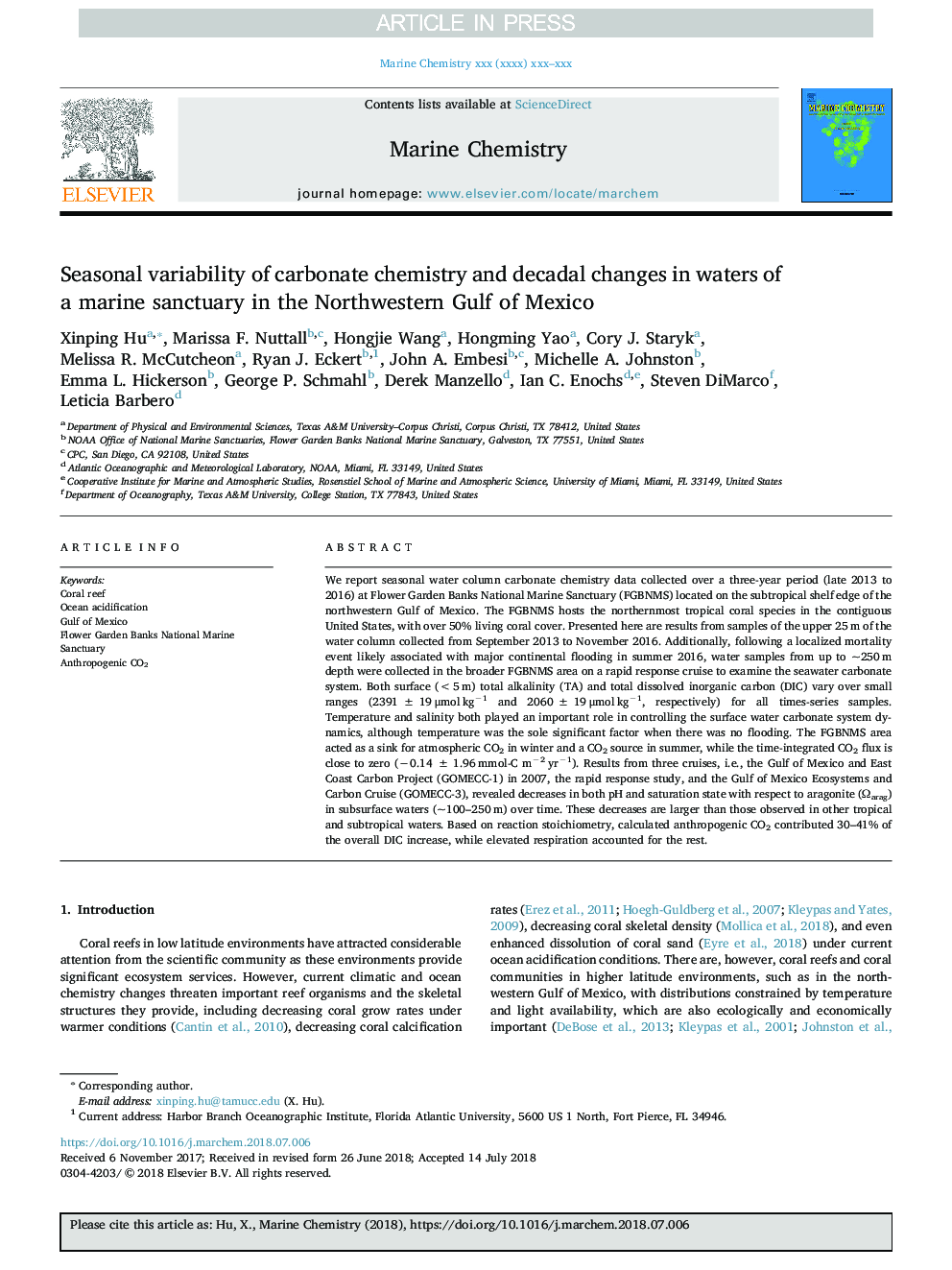| کد مقاله | کد نشریه | سال انتشار | مقاله انگلیسی | نسخه تمام متن |
|---|---|---|---|---|
| 10154606 | 1666308 | 2018 | 13 صفحه PDF | دانلود رایگان |
عنوان انگلیسی مقاله ISI
Seasonal variability of carbonate chemistry and decadal changes in waters of a marine sanctuary in the Northwestern Gulf of Mexico
ترجمه فارسی عنوان
تنوع فصلی شیمی کربنات و تغییرات دهه ای در آبهای ساحلی دریایی در خلیج شمال غربی مکزیک
دانلود مقاله + سفارش ترجمه
دانلود مقاله ISI انگلیسی
رایگان برای ایرانیان
کلمات کلیدی
موضوعات مرتبط
مهندسی و علوم پایه
شیمی
شیمی (عمومی)
چکیده انگلیسی
We report seasonal water column carbonate chemistry data collected over a three-year period (late 2013 to 2016) at Flower Garden Banks National Marine Sanctuary (FGBNMS) located on the subtropical shelf edge of the northwestern Gulf of Mexico. The FGBNMS hosts the northernmost tropical coral species in the contiguous United States, with over 50% living coral cover. Presented here are results from samples of the upper 25â¯m of the water column collected from September 2013 to November 2016. Additionally, following a localized mortality event likely associated with major continental flooding in summer 2016, water samples from up to ~250â¯m depth were collected in the broader FGBNMS area on a rapid response cruise to examine the seawater carbonate system. Both surface (<5â¯m) total alkalinity (TA) and total dissolved inorganic carbon (DIC) vary over small ranges (2391â¯Â±â¯19â¯Î¼molâ¯kgâ1 and 2060â¯Â±â¯19â¯Î¼molâ¯kgâ1, respectively) for all times-series samples. Temperature and salinity both played an important role in controlling the surface water carbonate system dynamics, although temperature was the sole significant factor when there was no flooding. The FGBNMS area acted as a sink for atmospheric CO2 in winter and a CO2 source in summer, while the time-integrated CO2 flux is close to zero (â0.14â¯Â±â¯1.96â¯mmol-C mâ2â¯yrâ1). Results from three cruises, i.e., the Gulf of Mexico and East Coast Carbon Project (GOMECC-1) in 2007, the rapid response study, and the Gulf of Mexico Ecosystems and Carbon Cruise (GOMECC-3), revealed decreases in both pH and saturation state with respect to aragonite (Ωarag) in subsurface waters (~100-250â¯m) over time. These decreases are larger than those observed in other tropical and subtropical waters. Based on reaction stoichiometry, calculated anthropogenic CO2 contributed 30-41% of the overall DIC increase, while elevated respiration accounted for the rest.
ناشر
Database: Elsevier - ScienceDirect (ساینس دایرکت)
Journal: Marine Chemistry - Volume 205, 20 September 2018, Pages 16-28
Journal: Marine Chemistry - Volume 205, 20 September 2018, Pages 16-28
نویسندگان
Xinping Hu, Marissa F. Nuttall, Hongjie Wang, Hongming Yao, Cory J. Staryk, Melissa R. McCutcheon, Ryan J. Eckert, John A. Embesi, Michelle A. Johnston, Emma L. Hickerson, George P. Schmahl, Derek Manzello, Ian C. Enochs, Steven DiMarco, Leticia Barbero,
